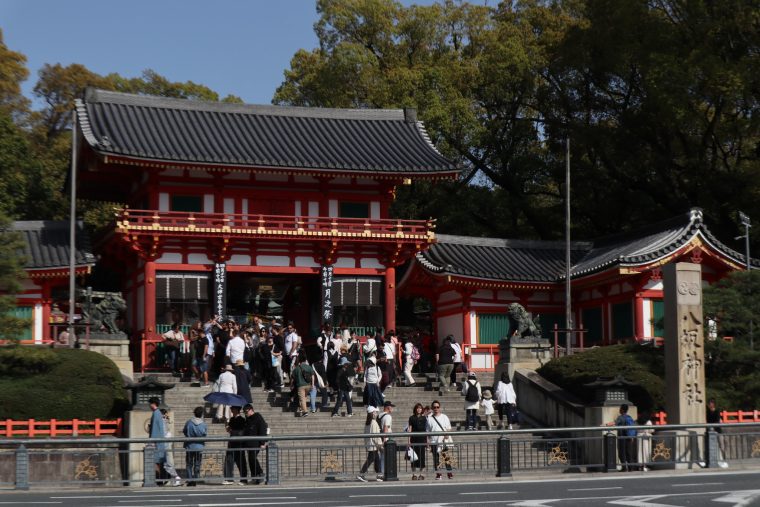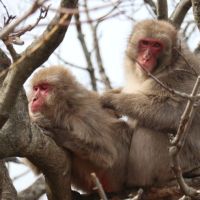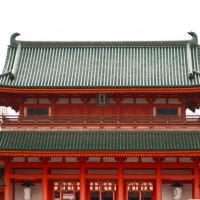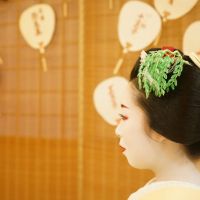Yasaka Shrine:A Sacred Oasis in the Heart of Kyoto
S-fleage
S-fleage is a Kyoto-based company. We are proud to introduce the charms of Kyoto to the world. We hope this article will help you to experience Kyoto.
Latest posts by S-fleage (see all)
- Fushimi Inari Taisha: Enchanting Gates to Eternity – History and Travel Guide - 2024/04/29
- Sanjusangendo (Sanjusangen-do) : A Temple Characterized by the Overwhelming Presence of Over a Thousand Buddha Statues - 2024/04/29
- Ninenzaka: Walking along the most emotional stone-paved slope in Kyoto - 2024/04/22
Contents
Introduction
Nestled amidst the bustling streets and vibrant culture of Kyoto, Yasaka Shrine stands as a timeless symbol of spiritual reverence and cultural heritage.
This sacred sanctuary offers a tranquil retreat from the modern world, inviting visitors to immerse themselves in the beauty and serenity of Japan’s ancient traditions.

In this article, we will explore the rich history and cultural significance of Yasaka Shrine, delving into its architectural splendor, revered rituals, and enduring allure.
Join us on a journey to discover the hidden treasures and profound spirituality of this iconic landmark at the heart of Kyoto.
Historical Background of Yasaka Shrine

Yasaka Shrine, also known as Gion Shrine, holds a significant place in Kyoto’s cultural and religious landscape.
Its history is deeply intertwined with the city’s rich heritage and traditions, making it a revered site for locals and visitors alike.
Yasaka Shrine’s cultural significance extends beyond its religious importance.
Origins and Foundation

Yasaka Shrine traces its origins back to the early Heian period in Kyoto, Japan.
It was originally established in 656 AD as Gion Shrine by the Emperor Saimei.
In 877, during another outbreak of plague, prayers were offered at the “Koshasha of Higashiyama” (Gion Shrine), and the epidemic subsided.
This event is considered a turning point in the shrine’s development.
Evolution and Renaming
Over the centuries, the shrine underwent several renovations and expansions, evolving into the grand complex it is today.
It was renamed Yasaka Shrine in 1868 after the Meiji Restoration.
Association with Gion Matsuri
Yasaka Shrine has a deep association with the Gion Matsuri, one of Japan’s largest and most famous festivals.
The Gion Matsuri is considered one of the three major festivals, alongside the Aoi Matsuri and Jidai Matsuri, making it part of the Kyoto’s three biggest festivals, Japan’s three major festivals, three major float festivals, and three major festivals for beauty.
It is a representative festival of Japan, held annually in July.
The shrine serves as the starting and ending point for the grand processions of floats during the festival.
Seasonal Events of Yasaka Shrine

Cherry Blossom Viewing
During the spring season, Yasaka Shrine is a popular spot for cherry blossom viewing, known as hanami.
The shrine’s grounds are adorned with beautiful cherry trees, attracting visitors from far and wide to enjoy the fleeting beauty of the blossoms.
Gion Matsuri
The Gion Matsuri, held annually in July, is one of the most significant events at Yasaka Shrine.
It features colorful processions of elaborately decorated floats, known as yamaboko, parading through the streets of Kyoto, with Yasaka Shrine serving as a focal point for the festivities.
Obon Festival
The Obon Festival, held in August, is another important event at Yasaka Shrine. It is a time for honoring and commemorating ancestors, with traditional dances, music performances, and offerings made to the spirits.
Autumn Foliage
In the autumn months, Yasaka Shrine is surrounded by vibrant foliage, making it a picturesque destination for autumn foliage viewing, known as koyo.
Visitors can enjoy the serene beauty of the shrine’s grounds adorned with red, orange, and yellow leaves.
New Year’s Celebrations (Hatsumode)
Yasaka Shrine is also a popular destination for hatsumode, the first shrine visit of the New Year.
Thousands of visitors flock to the shrine during the first few days of January to pray for health, happiness, and prosperity in the coming year.
Architectural Beauty

At the heart of Yasaka Shrine lies its majestic main hall, characterized by its distinctive vermilion color and elegant roofline.
The hall’s intricate wooden carvings and intricate details showcase the craftsmanship of ancient Japanese artisans, reflecting a rich cultural heritage.
Surrounding the main hall are several smaller shrines and structures, each with its own unique architectural charm.
From the graceful curves of the torii gates to the intricate patterns of the roof tiles, every element of Yasaka Shrine’s architecture exudes a sense of timelessness and beauty.
One of the most striking features of Yasaka Shrine is its serene garden, carefully landscaped to create a tranquil oasis amidst the bustling city streets.
Here, visitors can stroll along winding pathways, admire the seasonal blooms of cherry blossoms and azaleas, and find moments of peace and reflection.
Basic Information and Tips of Yasaka Shrine

9:00 AM to 5:00 PM (Office Hours)
Open for Visitation 24 Hours
At Yasaka Shrine, all commercial photography within the precincts is strictly prohibited.
This is to ensure the protection of cultural assets, the safety of visitors, and the smooth progress of shrine rituals and events.
The use of drones and other radio-controlled flying objects, bicycle entry, pet companionship, and smoking are also prohibited.
https://www.yasaka-jinja.or.jp/en/
Sightseeing spots around Yasaka Shrine
Surrounded by the bustling downtown area of Kyoto, Yasaka Shrine is encompassed by numerous tourist attractions.
Beyond temples and shrines, there are charming streets and scenic viewpoints that offer enjoyable experiences just by walking around.
Let’s take Maruyama Park, for example.
Situated near Yasaka Shrine, Maruyama Park is a tranquil oasis in the heart of Kyoto.
Known for its picturesque cherry blossoms in spring and vibrant foliage in autumn, the park offers a peaceful retreat from the bustling city streets.
Here are a few recommendations to consider for your travel itinerary. Please take them into account when planning your trip.
Pontocho Alley

Pontocho Alley is a narrow, atmospheric alleyway located in the heart of Kyoto, Japan.
It is famous for its traditional machiya buildings, which house a variety of restaurants, teahouses, and bars.
Pontocho is particularly popular for its charming atmosphere, especially at night when lanterns illuminate the alley, creating a magical ambiance.
Chionin Temple

Chionin Temple, located in the Higashiyama district of Kyoto, Japan, is one of the most significant temples in the country.
Established in 1234, it serves as the head temple of the Jodo sect of Japanese Buddhism.
Chionin Temple is renowned for its majestic architecture, including the massive Sanmon gate, which is one of the largest wooden gates in Japan.
The temple’s serene gardens and historical significance make it a popular destination for tourists and pilgrims alike.
Sannenzaka

Sannenzaka, or Sannen-zaka, is a historic cobblestone street located in the Higashiyama district of Kyoto, Japan.
It is famous for its well-preserved traditional architecture, including machiya (traditional wooden townhouses), shops, and restaurants.
The street leads up to the famous Kiyomizu-dera Temple, one of Kyoto’s most iconic landmarks.
Visitors can enjoy a leisurely stroll along Sannenzaka while immersing themselves in the atmosphere of old Kyoto.
How to get to Yasaka Shrine

Yasaka Shrine, a prominent historical landmark in Kyoto, Japan, is easily accessible by various modes of transportation.
Here’s how you can reach this captivating destination:
From Kansai international airport to Kyoto station
Navigating from Kansai International Airport to Kyoto Station offers various convenient options, allowing you to choose the mode of transportation that suits your preferences.
Airport Express Train (Haruka)
Purchase Tickets: Upon arrival at Kansai International Airport, head to the JR West Ticket Office to purchase tickets for the Haruka Airport Express Train bound for Kyoto.
Boarding the Haruka Train: Follow the signs to the Haruka train platform. The Haruka train departs directly from the airport and offers a comfortable and scenic journey to Kyoto Station.
Travel Time: The travel time on the Haruka train is approximately 75-80 minutes, providing ample time to relax and enjoy the picturesque views.
Airport Limousine Bus
Bus Terminal Location: Locate the Airport Limousine Bus Terminal at Kansai International Airport. It is on the first floor.
Purchase Tickets: Purchase your bus ticket to Kyoto Station at the terminal counter. Boarding the Bus: Board the Airport Limousine Bus bound for Kyoto Station.
Travel Time: The bus journey takes around 90-120 minutes, depending on traffic conditions.
Taxis and Rental Cars
Taxi Services: Taxis are available at the airport, providing a convenient but pricier option. Inform the driver of your destination, Kyoto Station.
Rental Cars
Rental car services are also available at Kansai International Airport if you prefer the flexibility of driving.
From Shin-Osaka station to Kyoto station
To travel from Shin-Osaka station to Kyoto station, you can take the JR (Japan Railways) Tokaido Shinkansen. The Tokaido Shinkansen is a high-speed train that connects major cities in Japan.
First, go to Shin-Osaka station and locate the Shinkansen platforms. Shin-Osaka is a major transportation hub, and you can easily find signs directing you to the Shinkansen area.
Purchase a Shinkansen ticket for the Hikari or Kodama train bound for Kyoto at the ticket counters or vending machines. Make sure to check the departure time and platform information.
Then proceed to the designated Shinkansen platform. Look for the train with the appropriate departure time and destination (Kyoto).
Enjoy the high-speed journey to Kyoto station. The travel time is relatively short (about 15-30min), and the Shinkansen provides a comfortable and efficient way to reach Kyoto.
From Kyoto station to Yasaka Shrine
https://maps.app.goo.gl/qD1V5Yj3C67R3ngY6
Kyoto Station, a bustling transportation hub in the heart of the city, serves as the starting point for many memorable journeys through Kyoto’s rich cultural landscape.
https://maps.app.goo.gl/JhTnCfikEtFHTgc89
Bus
Take the City Bus Route 100 or 206.
Get off at Gion bus stop.
Train
Approximately 5 minutes on foot from Keihan Electric Railway’s “Gion-Shijo” Station.
Approximately 8 minutes on foot from Hankyu Railway’s “Kyoto Kawaramachi” Station.
If you’re coming from JR Kyoto Station, taking a taxi is convenient.
If you’re up for a leisurely stroll and wish to soak in the sights and sounds of Kyoto, consider walking from Kyoto Station to Yasaka Shrine.
While it’s a longer journey compared to other modes of transportation, walking allows you to explore the city’s streets, uncover hidden gems, and experience the charm of Kyoto at your own pace.
My experience of Yasaka Shrine

Yasaka Shrine stands out prominently.
Facing a main street, it’s a place frequented by many tourists.
From Yasaka Shrine, you can access Maruyama Park, where you can leisurely stroll amidst nature on its expansive grounds.
You’ll encounter people painting pictures and playing the guitar in the park.
Be particularly cautious during cherry blossom season, as it tends to get crowded.
Yasaka Shrine: A Sacred Oasis

Yasaka Shrine stands as more than just a religious site; it is a sacred oasis that beckons travelers to immerse themselves in the rich tapestry of Japan’s cultural and spiritual heritage.
We encourage you to visit this historic Japanese heritage that captivates numerous tourists and experience it for yourself.




